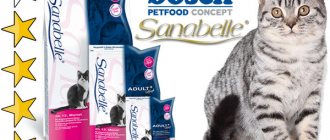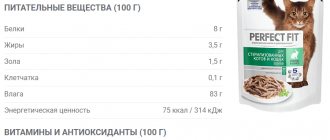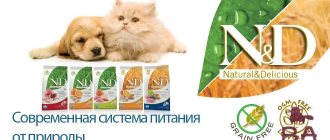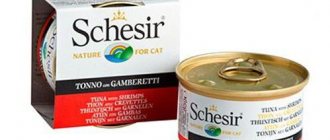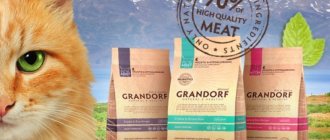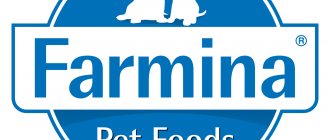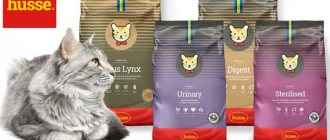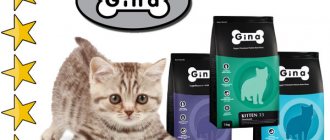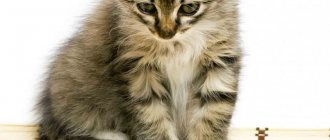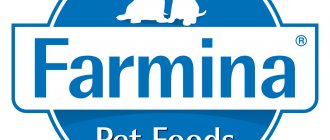The health and activity of a cat largely depend on the chosen diet. That is why you should learn to correctly read and understand the composition of dry cat food, and not believe advertising and colorful packaging. The staff of the Murkosha shelter will help you understand the nuances.
1) What is the main thing in the composition of dry food 2) About the ingredients in dry food 3) What healthy fats should be included 4) Are carbohydrates necessary? 5) Additional important ingredients 6) Which food is better to leave in the store 7) Which food to choose
Protein
Chicken Uses meat, skin and sometimes bones. Heads, paws, entrails and feathers are not used. The most “gentle” product. Dogs that do not digest meat ingredients well often digest chicken ingredients very well.
Chicken meal Obtained from chicken meat and skin. Chicken meal is perhaps the best protein product used in commercial feeds. Tasty, easily digestible and very expensive.
Chicken by-product meal Consists of ground up body parts of a slaughtered chicken such as neck, legs, undeveloped eggs and innards.
Turkey Uses meat, skin and sometimes bones. Heads, paws, entrails and feathers are not used. In no way inferior to chicken.
Turkey meal A very nutritious, easily digestible and appetizing product.
Duck Uses muscle tissue, skin and sometimes bones. Heads, paws, entrails and feathers are not used. An excellent source of proteins, which also contains amino acids important for the skin of dogs.
Salmon An excellent source of protein and Omega 3 fatty acids.
Salmon meal An excellent source of protein and Omega 3 fatty acids.
White fish Deep-sea fish of the whitefish family. An excellent product, rich in protein and Omega fatty acids.
Fish Cleaned fish and trimmings are used. An excellent component rich in proteins. It has a strong effect on the coat due to the content of phosphorus and other elements.
Ocean fish An excellent resource of fatty acids and proteins.
Fishmeal The dried, ground tissue of half-broken whole fish or pieces of fish, either or both, with or without the extraction of some of the oil. A nutritious product slightly inferior to whole fish. The specific varieties of fish are unknown.
Chicken eggs are rich in protein and amino acids.
Dry egg powder Egg powder is produced from egg processing waste (shells, undeveloped eggs, etc.). Their value is much lower than a whole egg.
Chicken liver is potentially dangerous. Primarily used to improve the palatability of feed. Like any liver, it can contain toxins.
Poultry liver is potentially dangerous because... Without identifying a specific animal in the name, it is impossible to say which liver (goose, duck, chicken) was used in the production of feed. In addition, the liver of animals often retains remnants of toxins.
Poultry by-product meal is potentially dangerous. Includes liver, kidneys, brains, etc. Almost any part of the animal carcass, except meat, can be part of this ingredient. Much less nutritious than meat. The specific composition is unknown.
Soy protein concentrate is potentially allergenic! Protein concentrate is obtained from dehydrated and defatted soybeans. Used to reduce the cost of feed. Often the raw material used to obtain the concentrate is a genetically modified product. In addition, soybeans often cause allergies in some animals.
Animal mixture - potentially allergic. Dry material obtained by chemical and/or enzymatic hydrolysis of clean and undisintegrated tissue. Animal tissues used must be free from hair, teeth, hooves and feathers, except in the minimum amount that is inevitably present even with good production processes and is suitable for animal feeding.
––– 5. Calculate “maintenance energy” (SE) - the required number of calories per day
So how do you calculate the correct amount of feed? You need to start by determining your cat's energy expenditure. Veterinarians use the concept of “sustained energy” (SE) - this is the number of calories that a moderately active adult animal spends per day in a familiar environment at room temperature. This indicator depends on the weight of the pet. Here are the calculation formulas and a reference table.
Calorie calculation for cats weighing up to 2 kilograms
PE (kcal/day) = 1.4 [70 x (weight (kg))* 0.75] - where 0.75 is the power to which you need to raise your current weight
Carbohydrates
Potatoes are used with the peel, which contains all the useful substances. Potatoes contain carbohydrates, zinc, copper, iron, potassium, magnesium, vitamins B and C, and niacin.
Sweet Potatoes Potatoes contain carbohydrates, zinc, copper, iron, potassium, magnesium, vitamins B and C, and niacin. Sweet potatoes are also rich in beta-carotene, etc. They do not cause allergies.
Flaxseed meal A source of Omega-3 and Omega-6 fatty acids. Thanks to this component, the wool looks soft and shiny. An anti-constipation remedy with anti-carcinogenic properties. The best plant source of alpha-linoleic acid.
Barley Whole grain barley is a very good and high-quality source of carbohydrates.
Crushed barley Crushed grain is not a particularly valuable component, since during the processing all useful substances were removed from it.
Hercules Dry product from purified oat grains. An excellent source of carbohydrates, rich in vitamin B. Sometimes used as a binder for dry food, which avoids artificial fixatives.
Oat gluten Gluten from oat processing products. Poorly absorbed by the body.
Rice Whole, refined grains of rice without bran, called white rice, are a high-quality source of carbohydrates, protein and gluten. In addition, it is a natural remedy for consolidating stool and lowering cholesterol levels. The least allergenic grain product.
Rice Flour Rice flour, like broken rice, is much less valuable than whole grains.
Beer rice Dry extracted grain residue formed after the production of wort (the liquid part of malted grain) or beer and may contain dusty dry spent hop cones in an amount not exceeding 3%. Cheaper and less valuable product compared to whole rice.
Millet is quite a nutritious filler. But biologically less suitable for animal nutrition than other grain crops.
Sorghum is a nutritious product that is extremely difficult for animals to digest. Can lead to severe digestive disorders!
Corn is potentially dangerous because... widely used in feed as a cheap source of protein, not always of high quality.
Corn gluten/corn flour - potentially allergic! Grain vegetable protein. The shelled part of the grain that remains after most of the starch and protein have been extracted in the process of producing starch or molasses. Cheap filler. It is an allergen for many animals.
Cellulose powder is potentially dangerous. Usually made from corn milling. Used as a filler and binder to reduce the cost of feed.
Wheat/Wheat flour - potentially allergic. A good source of carbohydrates, nutritious filler, rich in vitamins and minerals. Unfortunately, it causes an allergic reaction in many dogs.
Wheat gluten is potentially allergenic. A cheap by-product formed during grain processing. It has virtually no nutritional value and serves mainly as a binder.
Beet pulp An extract isolated during the processing of beets for the production of sugar, as well as its dried version. Natural stool fixative.
Dried beet pulp Dry extract obtained from the processing of sugar beets. Natural stool fixative.
Vegetable Blend A source of plant fiber from a mixture of various plants and vegetables.
Comparison of dry cat food
Manufacturers produce economy, premium and super premium food. However, the names are largely arbitrary and there are products of intermediate quality that can be classified into one or another class.
Economy class cat food
All pelleted foods are low to moderate in price and widely available. They can be bought in supermarkets.
The following products are popular:
- Friskies : contains mainly vegetable proteins; from the information on the packaging it is not clear what the food is made of. There is no specialization by age. Lots of negative reviews. However, the low price makes the food popular.
- Kitekat : It is not clear what the granules are made of. However, the food price is inferior even to Friskies. There are few positive and negative reviews. Manufacturers recommend this food for cats of all ages.
- Perfect Fit : good quality economy class food, a little short of premium. Easily available, available in all stores. Characterized by a wide range. There are foods for kittens, lactating, elderly, adults, castrates and even hypoallergenic food. Quite high quality food. However, veterinarians do not recommend it for cats involved in breeding.
Economy class meals are not nutritionally balanced and are made from ingredients that do not have an attractive taste. Therefore, feed mixtures are enriched with taste correctors
Premium cat food
Premium food products are sold in pet stores.
The following products are popular:
- Probalance : they make options for kittens, animals with sensitive digestion, weakened immune systems and castrates. The manufacturer positions the food as premium, but demanding consumers believe that the nutrition does not live up to this rating.
- Brit premium is produced for young animals, adults, castrates, pets with sensitive digestion, prone to obesity, and the elderly. The products are widely distributed, affordable, and do not have many complaints.
- Royal Canin is popular in Russia, always available in pet stores, and is characterized by a wide range, including veterinary. Reviews are contradictory - from enthusiastic to negative.
Be sure to read:
Proplan or Royal Canin: which food is better for cats, comparison, how to choose the best
Super premium cat food
Manufacturers classify some super-premium food as holistic, that is, made from products suitable for human nutrition.
The following dehydrated granules are in demand among cat owners:
- Grandorf : prevents diseases of the joints, heart, and urinary tract. The formula of the feed mixture contains components that prevent the formation of tartar, normalize digestion in the large intestine, and ensure healthy skin and beautiful coat. A recipe has been developed for all ages and physiological conditions
- Monge : food is presented in classic and functional lines. The standard version includes food for all ages. The functional line is represented by food for long-haired cats, pets living in multi-storey buildings, suffering from urolithiasis, and susceptible to allergies.
- Brit Care brand produces the following types of food for pets of all ages, neutered animals prone to obesity, pregnant lactating females and kittens.
Fats
Chicken fat A very important component for skin and coat. The richest animal source of linoleic acid (>23%).
Sunflower oil is especially beneficial for the skin and fur of animals. In terms of its usefulness, it ranks first among other oils used for the production of dry food.
Fish oil - salmon/anchovy. Fish oil is an excellent source of Omega fatty acids and vitamins.
Rapeseed oil
Poultry fat is potentially allergic! A product obtained from poultry through an industrial rendering or extraction process. Poultry fat, when the specific type of poultry (chicken, duck...) is not specified (unknown), contains a very small amount of linoleic acids, and various preservatives (antioxidants) may be used during the production process.
Animal fat Animal fat is inferior in the content of beneficial acids to chicken fat.
Pork fat Pork fat. - no comments!!!! The presence of this component in cat food is, to put it mildly, upsetting!
Wet cat food: comparison
Wet food is considered a complement to dry kibble. Most often, canned food and pates are offered to pets in the form of treats. Veterinarians recommend switching pets to soft food during the recovery period after illness or planned operations. Among cat lovers, wet food from the same manufacturers that produce dry kibble is popular.
However, there are premium and super premium treats that do not have granular analogues;
- Felix;
- Sheba;
- Schesir.
The wet foods listed are compatible with granular products of at least premium quality and are used to diversify the diet.
The link to the full version of the cat food comparison table is here
Fruits and vegetables
Alfalfa Alfalfa contains a number of proteolytic enzymes that break down proteins and promote their absorption. Alfalfa is an essential source of chlorophyll, vitamins and protein, including iron and magnesium. Promotes the healing of erosions, ulcers, open wounds, helps in the fight against infection. In addition, it increases lactation in nursing mothers. Sprouts, Leaf, Meal and other components of alfalfa are often used in feed.
Apples are rich in soluble carbohydrates and gluten, vitamins and pectin. Contains beta-carotene, potassium and boron.
Carrots The best source of vitamin A is beta-carotene.
Cranberries are very beneficial for the kidneys and genitourinary system. Natural urine acidity regulator.
Peas Green peas are rich in vitamin A and are a source of vegetable protein.
Cranberry powder Grinding dried cranberries
Blueberries can sometimes be found in expensive foods for capricious animals. Rich in useful substances.
Spinach Fresh spinach leaves are rich in vitamins A and C and also contain iron.
Parsley This plant is valued not only for its taste. It has powerful healing properties. Parsley is rich in vitamin C, b-carotene, and contains a lot of chlorophyll, a plant pigment that has been called a “natural disinfectant” for its ability to reduce body odor and reduce the carcinogenic effect of oxidation. Parsley has a diuretic effect, accompanied by increased release of salts from the body, increases the tone of the smooth muscles of the uterus, intestines and bladder.
Tomatoes are very rich in vitamin C. Whole tomatoes are used and then boiled. Heat treatment of tomatoes makes them very beneficial for the reproductive system, especially for males.
Tomato mixture is potentially allergic! A mixture of tomato skin, their seeds and pulp, a second-class product. Leather makes up a large percentage of this mixture, which increases the likelihood of a high content of pesticides in this component, since they are used almost everywhere when growing tomatoes.
Additional Important Ingredients
High-quality dry food should be balanced and contain vitamins, minerals and other additives. Any complete food for cats, regardless of its quality, contains the necessary macro- and micronutrients within the normal range. This is achieved by including a vitamin-mineral complex, which in nature the cat receives naturally.
Read more: What vitamins does a cat need?
Balanced dry cat food contains all the necessary vitamins and microelements. This food is as close as possible to the natural food of a small predator. With each serving of dry food, the pet will receive everything it needs for healthy living, which cannot be said about homemade food - in this case, it is quite difficult to calculate the necessary nutrients for the cat. Even if you feed your cat vitamins at home, this does not guarantee coverage of the daily requirement for useful microelements and, most importantly, protein. We advise you to buy ready-made dry food for your kitten to keep him healthy and energetic, and we will tell you below which foods you should pay attention to and which ones to leave on the shelf.
Medicinal plants
Dandelion Dandelion contains active substances: sesquiterpene lactones, a complex of vitamins and minerals, especially a lot of potassium, etc. Biological effects of dandelion: pronounced choleretic and diuretic, detoxifying, stimulates the activity of the digestive glands, etc.
Chamomile Chamomile is used in medicine as a sedative, anti-inflammatory, antiseptic, analgesic, antispasmodic, carminative, diaphoretic, choleretic, and antiallergic agent.
Calendula extract has anti-inflammatory, bactericidal (especially against staphylococci and streptococci), wound healing, astringent and diuretic effects. It has an antimicrobial effect and promotes tissue regeneration. Alcohol infusion is used for stomatitis and periodontal disease.
Preservatives and binders
Rosemary A cancer preventative, it is also an excellent preservative, which is why it is added to dry food.
Citric acid Natural preservative. It is found in large quantities in lemons, from which it was first obtained. Currently, it is obtained from shag stems, currants, lingonberries, rowan berries and much more.
Phosphoric acid Antioxidant, acidity regulator
Starch
Chemical preservatives BHA/BHT (aka BHA/BHT) In some countries, they are banned for use in canned food for humans, but they continue to be used for animals!
BHA (Additive E320, Butylhydroxyanisole) The International Agency for Research on Cancer says that BHA is a human carcinogen. BHA also chemically interacts with nitrates, as a result of which the compounds acquire mutagenic properties, that is, they cause changes in the DNA of cells. In many countries, BHA is listed as a red food additive, meaning it has the highest level of danger.
BHT (additive E321, Butylhydroxytoluene) is of synthetic origin and has a high level of danger (if systematically used, it is significantly harmful to health). It is thought to cause hyperactivity in some children and may also increase the risk of cancer.
Propyl gallate has an effect on the body similar to the effect of the female sex hormones estrogen. The food additive E310 causes asthma, stomach irritation and allergic skin rashes, as a result of which the use of this additive is prohibited in the production of baby food, especially for young children, and it can easily be present in kitten food! Some scientists have suggested that propyl gallates may cause the growth of malignant tumors, but this issue has not been fully studied.
Why is a low-protein diet indicated for chronic renal failure?
Many representatives of artificially bred breeds have kidney problems. The most common among them is kidney failure. In addition to congenital pathology, its cause may be other diseases, deficiency of beneficial microelements, poisoning, and hypothermia.
A cat that has been diagnosed with this disease needs treatment and special nutrition. Her metabolism is disrupted, the body cannot (fully or partially, depending on the stage) remove metabolic products. As a result, a large number of toxins enter the blood. In the absence of timely, competent therapy, the animal dies. Fortunately, effective treatment methods have already been developed and there are drugs. If the disease is “caught” at an early stage, then a caring owner can provide his furry friend with a long, fulfilling life.
Nutrition in the treatment of chronic renal failure is of considerable importance. It can either help achieve significant improvement or make the situation worse. Typically, veterinarians will prescribe a lifelong low-protein diet.
Reducing protein in the diet inhibits hyperfiltration, which leads to degradation of kidney tissue and reduces general intoxication due to excess urea.
Flavors and flavoring additives
Chicken seasoning Natural food flavoring additive. An excellent natural “apitizer” obtained through the hydrolysis of chicken parts and tissues.
Chicken liver seasoning Natural food flavoring additive.
Sea salt Table salt, extracted from sea water, is practically no different from ordinary salt.
Iodized salt Table salt is used to improve the palatability of food.
Salt Most ingredients already contain salt, and an excessive amount of it in food will in no way benefit the animal.
Garlic seasoning Flavor and flavoring addition to the menu
Natural flavors Contain no artificial ingredients. Basically, these are various extracts of strong broths: chicken, beef and lamb with the addition of herbs and spices.
Peppermint Refers to spices used as aromatic and flavoring additives. Peppermint is believed to help with stomach upsets and inhibit the growth of some bacteria.
Savory The homeland of garden savory is the eastern regions of the Mediterranean and Black Sea region. It was well known to the ancient Greeks and Romans. In the manuscripts of Virgil there are recommendations for using it in food to flavor it. It was especially popular in England, Germany, Scandinavia, etc.
Fennel In appearance it resembles dill, in taste and aroma it is closer to anise, but with a sweeter and more pleasant taste.
Features of the body of kittens: what the owner needs to know
In the first year of life, kittens grow rapidly, gain weight, and master the necessary skills. It is important for their owner to know what changes occur in the baby’s body during a specific period, so as not to miss anything. So:
- 10 days. At the age of 1.5 weeks, a kitten is considered a newborn; it weighs about 100 g. Its eyes are not yet open, it cannot hear, there is no thermoregulation, and the sense of smell is not developed. He finds his mother cat thanks to the warmth emanating from her. During this period the baby only eats and sleeps. Newborns cannot be picked up unless there is a threat to their life and health.
- 2 weeks. The cat gains weight (approximately 100-150 g), its eyes begin to open, it hears, and its sense of smell appears. The kids communicate with each other and their parents and try to crawl. Since the skeleton is not yet strong, the kitten can be carefully picked up, lifting it to a small height from the soft bedding.
- 3 weeks. All sense organs are formed and begin to work. However, it is still difficult for kittens to navigate indoors. The muscles are still weak, but there are attempts to stand on their feet. Nutrition during this period can be mixed - mother's milk and some complementary foods.
- 4 weeks. The baby is growing up, gaining weight, and moving actively. About 25 teeth appear.
- 5-6 weeks. Weight is 600-900 g. Deworming can be carried out. It is best to show your pet to a veterinarian, who will assess the state of health and development and give the necessary recommendations.
- 7-8 weeks. You can wean him from his mother, transfer him to industrial and natural food, and get his first vaccinations. Weight is about 1 kg.
- 3 months. The animals are active, playful, curious, display individual character traits, and become independent. They can be taken to a new home; the small animal quickly adapts to new conditions and its owner. During this period, gender is already clearly determined.
- 4-6 months. The cat is quite well formed, the features of an adult animal appear. With proper care - socially adapted, weighs 1.5 kg. Teeth begin to change, the process is completed by 8 months.
- 7-8 months. Kittens reach a weight of 2 kg, large ones - about 3 kg, and begin to wash themselves regularly. The “children’s” fur falls out and is replaced by “adult” fur, which feels a little rougher to the touch. The owner can help the pet by cleaning its ears and eyes with special hygiene products for animals. You can castrate or sterilize.
- From 9 months to 1 year. The pet’s body is almost formed, the animal masters all the skills of an adult cat, gains weight, and reaches optimal growth.
From the age of 1 year, the animal is considered an adult, fully formed.
Enzymes and probiotics
Lactobacilli Diseases, stress, dietary errors, unfavorable environmental conditions, radiation therapy, long-term antibiotic therapy disrupt the normal balance of intestinal microflora, which leads to the growth of pathogenic microorganisms and, as a result, dysbiosis. The ability to suppress the proliferation of pathogenic microorganisms in the intestines is a distinctive property of lactic acid bacteria (Lactobacillus rhamnosus, Lactobacillus acidophilus). Lactic acid bacteria take an active part in the formation and homeostasis of the immune system; their metabolic products weaken the harmful effects of toxic substances entering the body due to environmental pollution.
Bacillus Probiotics. Freeze-dried bacteria to restore the microflora of the stomach and intestines. Bacillus subtillus, Bacillus lichenformis, Bacillus coagulins
Inulin is a polysaccharide found in the tubers and roots of dahlias, artichokes and dandelions. It is a fructosan because its hydrolysis produces fructose. It has been shown that inulin, in addition to stimulating the growth and activity of bifidobacteria and lactobacilli, increases calcium absorption in the large intestine, i.e. reduces the risk of osteoporosis, affects lipid metabolism, reducing the risk of atherosclerotic changes in the cardiovascular system and, possibly, preventing the development of type II diabetes mellitus, there is preliminary evidence of its anticarcinogenic effect.
Mannanoligosaccharides Enterococcus faecium
What to look for when choosing and comparing
The analysis of cat food involves the consideration of several characteristics. The latter include :
- country of origin (here the leaders are traditionally considered Canada, USA, Germany, Great Britain, Denmark);
- consistency of food (dry or wet);
- ingredient composition (one of the most important factors when choosing and comparing);
- class (economy, premium, superpremium, elite).
It is difficult for the average person to understand the variety of food on the shelves of modern stores. Someone pays attention to the packaging, which is stupid, to say the least. Others take into account the brand (popular or not). However, it is easy to make a mistake here too.
The big name of the manufacturer is not a guarantee that the food is good. Some brands are simply widely advertised, but the quality leaves much to be desired. Other manufacturers are undeservedly on the margins, but at the same time they produce an excellent product.
It is difficult for the average person to navigate today's variety of products on store shelves and veterinary pharmacies. To objectively compare the composition of feed and other characteristics, he simply lacks knowledge. The information below, based on data from experts, will help solve this problem.
